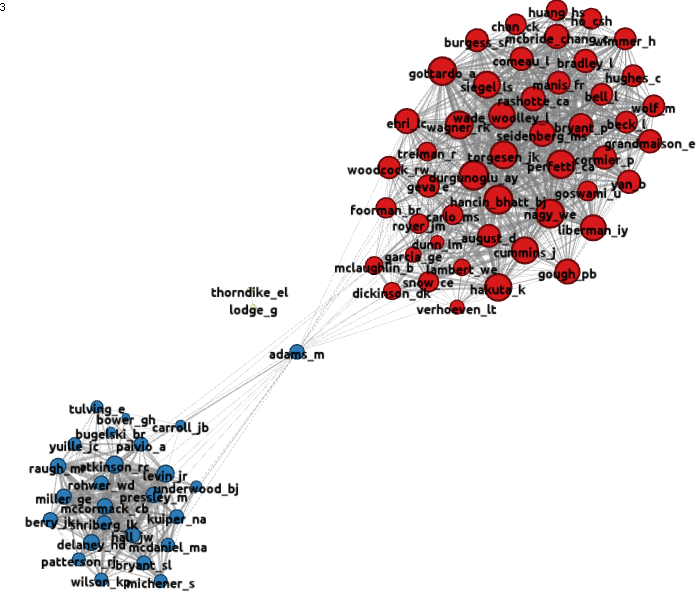 |
||
Lognostics Maps
|
||

|
data source: VARGA JEdPsych: data analysis: July 2015 data: 57 papers, @@ nodes, @@ co-citations, 2 clusters threshold for inclusion: Authors must be cited in at least four different papers. Co-citations occurring less than twice are excluded. Nodes are sized according to their betweenness centrality. @@ authors are cited in at least four of the papers in the Journal of Educational Psychology data. This number is close to the conventional figure of 100 authors usually used for co-citation analysis. This map summarises the co-citation patterns that appear in a set of 57 papers published in the Journal of Educational Psychology between 1915 and 2010.
Points to note in this map are the following: The map identifies only three research clusters in this journal. One of these clusters, Thorndike and Lodge (sic) is detached from the other two clusters, but the connections between the two larger clusters are extremely tenuous - the two groups are held together mainly by common citations of Adams. Readers familiar with other maps in this series will be struck by the almost complete absence of common reference points. None of the major L2 vocabulary researchers appear in this map, and few linguists are to be found here. The few exceptions to this generalisation include WE Lambert, B McLaughlin, JB Carroll, J Cummins and WE Nagy. The smaller of the two main clusters is mainly concerned with the use of mnemonic methods in L2 vocabulary acquisition. This cluster includes a number of authors publishing alongside Michael Pressley. The other authors in this cluster are psychologists working on imagery and memory. It is perhaps significant that Pressley was the editor of the Journal of Educational Psychology at this period. For the larger, even more densely connected cluster in the Northeast sector of the map, it is difficult to find a single theme that succinctly summarises what the cluster is about. Reading in L1 and L2 seems to be a concern, and so does the linguistic performance of young bilinguals, but it is difficult to be more specific than this. The role of M Adams in this map perhaps requires some explanation. Given that the two main clusters are very heavily factionalised, we might ask why is Adams the one person who is most strongly co-cited alongside members of both of the two larger clusters. I suspect that this unexpected link is actually a case of mistaken identity. MJ Adams published in 1991 a contentious book called Beginning to Read, and this is cited a number of times alongside authors in the large cluster in the map. M Adams was second author of an unpublished paper presented in 1980 at a conference on imagery. It is probable that these two authors are not in fact the same person, and if this is the case then the JEdPsych map actually consists of two large clusters that seem to be almost completely aware of each other's existence. Only JB Carroll and Barry McLaughlin provide a tenuous link between the two strongly factionalised clusters. If this reading is correct, then it emphasises the very marginal role that research on mnemonics has had on mainstream L2 vocabulary acquisition. The overall map also fails to give any importance to some significant work that was published in the Journal in the 1920s and 1930s. I think this work doesn't show up here because of the rather unusual citation practices that were in vogue at this period. I will be looking at other ways of mapping this early work in later postings.
|
© 2015 Paul Meara